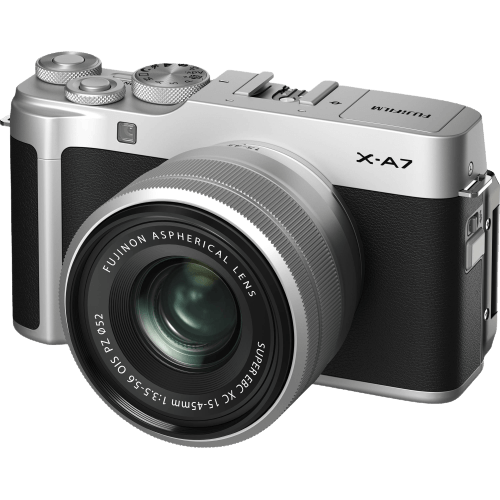Fujifilm X-A7 Specs and Scores

The Fujifilm X-A7 scores a 64 out of 100 in our evaluation. This mirrorless camera was announced on September 12, 2019, and released in the same year. With a launch price of $699, the X-A7 measures 119 x 38 x 41mm and weighs 320g or 0.71lbs.
Considering its specifications, the X-A7 holds its own in the current market. Its compact size and lightweight design make it a convenient choice for photographers on the go. While it may not be the highest-scoring camera, the Fujifilm X-A7 offers solid performance and value for its price.
Fujifilm X-A7 Overview and Optics
The Fujifilm X-A7 receives a score of 63/100 for its optics. This camera features a 24-megapixel APS-C CMOS sensor and a Fujifilm X lens mount. The shooting speed stands at 8 frames per second, which is decent for casual users. However, it lacks image stabilization, which may affect the quality of handheld shots.
In the current market, the X-A7’s specifications are satisfactory for beginner photographers and hobbyists. The 24-megapixel sensor provides a good balance between image quality and file size. Meanwhile, the Fujifilm X lens mount offers compatibility with a wide range of high-quality lenses.
The absence of image stabilization is a drawback, as it limits the camera’s low-light performance and may result in blurry images when shooting handheld. The aspect ratio of 16:9 is standard for most cameras and offers versatility for various shooting situations.
The Fujifilm X-A7’s optics are suitable for entry-level users but may not satisfy more advanced photographers. The camera’s score reflects its capabilities, which are adequate for casual shooting but might not meet the demands of professionals or enthusiasts seeking top-notch image quality and performance.
Fujifilm X-A7 Video Performance
The Fujifilm X-A7 scores an impressive 83/100 in video capabilities. This camera offers a maximum video resolution of 4K, with dimensions of 3840 x 2160, ensuring high-quality video footage. The ability to capture video at 60fps allows for smooth motion and excellent detail in fast-moving scenes.
A standout feature of the X-A7 is its built-in time-lapse functionality. This allows users to easily create stunning time-lapse videos without the need for additional equipment or software.
Considering the current market, the Fujifilm X-A7’s video specifications hold up well against its competitors. Its combination of 4K resolution, 60fps frame rate, and time-lapse capabilities make it a strong contender for those seeking a camera with excellent video performance.
Fujifilm X-A7 Features and Benefits
The Fujifilm X-A7 receives a feature score of 74/100. This camera offers a 3.5-inch touchscreen with a screen resolution of 2,760,000 dots. The flip screen capability enhances its versatility for various shooting angles. However, the camera lacks GPS functionality, which could be a drawback for some users.
In terms of connectivity, the X-A7 stands strong in today’s market with both WIFI and Bluetooth capabilities. These features enable quick and seamless sharing of photos and videos with compatible devices.
Taking all these aspects into account, the Fujifilm X-A7 possesses a commendable array of features that cater to the needs of photographers and videographers alike. While it may not be perfect, the camera’s specifications make it a competitive option in the current market.
Fujifilm X-A7 Storage and Battery
The Fujifilm X-A7 scores 29/100 in storage and battery. It has one memory card slot that accepts SD, SDHC, and SDXC cards, ensuring compatibility with UHS-I cards. In today’s market, this is standard for entry-level cameras, but more advanced models offer dual card slots for added flexibility and storage capacity.
The X-A7’s battery life is 270 shots per charge, which is lower than some competitors in its class. The camera uses an NP-W126S battery, and it supports USB charging, making it convenient for on-the-go charging. While the battery life may be sufficient for casual shooting, it falls short for extended photography sessions or professional use. The storage and battery capabilities of the Fujifilm X-A7 are satisfactory for its target audience, but there is room for improvement.
